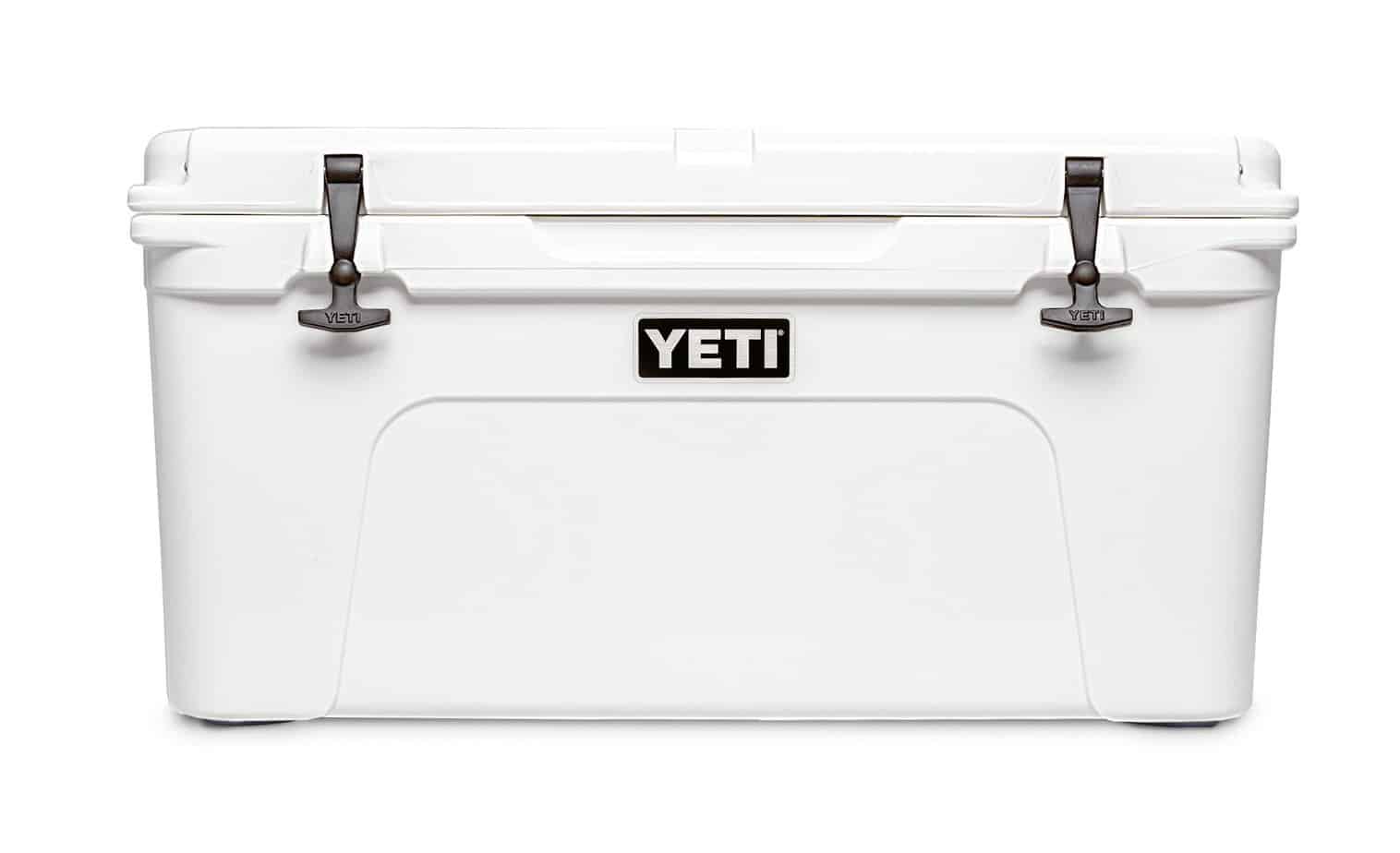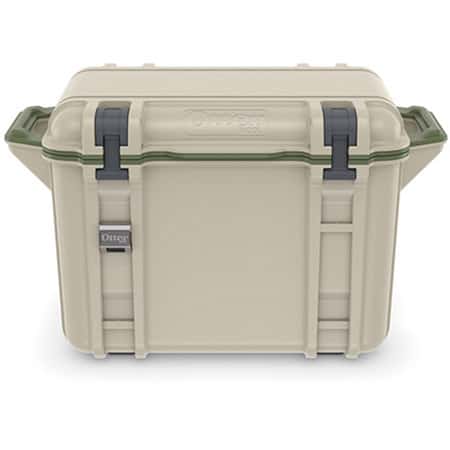If you are in the market for a new cooler, this Otterbox vs Yeti Coolers comparison is ideal for you to find out which one is best. Having a solidly built and premium cooler can make the world of difference when you go camping, head down to the beach or if you just need to keep drinks cool at a party.
Rather than investing in a poorly made cooler that won’t keep the contents cool and will likely break after a few trips away, the Otterbox and Yeti coolers are manufactured to last. Let’s have a look at how the Otterbox cooler line and Yeti shape up with their cooler range to find out which one is the best to buy.
Table of Contents
Main Differences Between Otterbox vs Yeti coolers
The main differences between Otterbox vs Yeti coolers are:
- Otterbox coolers are manufactured in the USA, whereas Yeti coolers are made overseas.
- Otterbox coolers are limited to just a few colors, whereas Yeti coolers have more color options.
- Otterbox coolers have protruding handles at the side, whereas Yeti coolers do not.
- Otterbox coolers have rubber latches that lock upwards, whereas Yeti coolers have the traditional T-Rex latches.
- Otterbox coolers need an extra locking system, whereas with Yeti coolers you can use the standard padlocks.
Many other cooler brands have come a long way, but Yeti is still the frontrunner. I personally could not compromise on the quality construction, durability, and functional design of the Yeti products. Generally a bit more expensive, but LASTS LONGER. #WorthIt.
Exploring Otterbox and Yeti Cooler features
Both Otterbox and Yeti coolers have several features in common and we’re going to show you them here.
You can find information on the differences between these two cooler manufacturers further down in this comparison article.
Roto-Molded Cooler Construction
Regardless of what outdoor activity you are pursuing, if you intend on taking a cooler with you it needs to be constructed well.
Inevitably the cooler is going to suffer a bit of rough and tumble at some stage whether it is dropping it down a hill or it being attacked by a curious animal. Both Otterbox and Yeti coolers are made from roto-molded polyethylene plastic which means they are durable. Very durable and rugged cooler options.
In fact, it is an almost indestructible material that should stand up to the rigors of the great outdoors.
If you are looking for a cooler that can withstand (almost) anything you can throw at it then the Otterbox and Yeti coolers are fantastically well made.
Ice Retention (Ice Cooler Test)
If you haven’t purchased a cooler for a while you’d be surprised at how far the technology has come on. No longer are you hoping that the ice stays in the cooler for the whole day before it starts to melt (melted ice) – these days coolers can retain ice for days or even a week (ice life), whether using an ice pack, block ice, or ice cubes (as an ice chest).
What about Otterbox and Yeti coolers?
This can vary depending on the climate you are in and also how often you are opening and closing the cooler so these numbers should be taken as a general figure.
Otterbox does claim that their Otterbox cooler models can hold ice (ice cooler) for well over a week (over 10 days in some cases) and Yeti are similar. In slightly less warm conditions there is no reason why a cooler from either Otterbox or Yeti can’t retain ice for up to 10 days and in warmer climates, I’d put this figure at around 5 days to a week.
Still, that is pretty good and means you don’t need to worry about the ice in your cooler melting in the short term when you are away.
Thick injection-foam insulation
How do Otterbox’s coolers and Yeti coolers actually keep the ice solid so it doesn’t melt?
The answer is something called polyurethane which is used to form the injection foam insulation in the coolers by these two brands. It forms an insulating layer between the contents and the outer casing of the cooler. It’s 3 inches thick on the walls and 3 inches thick at the lid.
Not only does this help to retain ice and keep the contents of your cooler chilled but it also forms another protective barrier further adding to the overall durability of these coolers.
Metal Hinges
Just to add to the high level of durability both of these coolers have, they come with metal hinges instead of plastic.
This is good for a couple of reasons.
One is that they are unlikely to break. I’ve had many coolers in the past that I’ve used to store drinks and various types of food when outdoors and they have come with plastic hinges.
For the most part, they are OK however one strong yank or if it falls and hits the ground at a weird angle they can break. Not good.
However, the metal hinges that both of these coolers come with are strong and aren’t going to break either. It also means the lid doesn’t detach from the body either which is a bonus in my eyes.
Protection against bears/wildlife: Otterbox vs Yeti Cooler
Hopefully, it isn’t something that you have to deal with but curious wildlife – and particularly bears on certain trails and areas – can be a problem. They’re attracted to whatever you have in the cooler so you want the cooler to be as wildlife-proof as possible.
Both the Otterbox and Yeti coolers are deemed to be bear/wildlife proof as long as you have a padlock installed. The durability of the coolers means that they are very very tough to get into however a padlock is required.
This is one area where both Otterbox and Yeti slightly detach from each other. While they both market their coolers as being bear-proof as long as you have padlocks installed – on the Yeti you can use any kind of padlock whereas the Otterbox requires one of their locking kits which come at an additional expense.
Features unique to Otterbox Coolers
From a day-trip hike to a weekend trek to a week-long+ disappearance into the woods, Venture gives you a right-size cooler for every adventure.
Now that you know how coolers from Otterbox and Yeti are very similar, what about their differences? Otterbox has three main features that are unique to their coolers that you won’t find on a Yeti model.
Firstly, their coolers have protruding handles on the sides. I’m a bit neutral on this because on the one hand, it does make the cooler easier to carry but on the other, it takes up more space when you are transporting the cooler.
They also have rubber latches that you pull up from the bottom and thirdly Otterbox coolers have room for external attachments.
You can add accessories such as bottle openers, cup holders, etc… onto the cooler which is a pretty cool feature. That being said, it is limited to 4 accessories and you do need to buy them from Otterbox which means they aren’t going to come cheap.
One last thing to tell you about Otterbox coolers (and it isn’t a feature as such) is that they are all made and manufactured in the USA whereas Yeti coolers are made abroad.
Features unique to Yeti Coolers
Many other cooler brands have come a long way, but Yeti is still the frontrunner. I personally could not compromise on the quality construction, durability, and functional design of the Yeti products. Generally a bit more expensive, but LASTS LONGER. #WorthIt.
What about the unique features that you will find on Yeti coolers that you won’t get on the Otterbox models?
One thing you will notice with Yeti coolers is that they come in a wide variety of colors and they certainly offer more than Otterbox. Having a ‘stylish’ looking cooler isn’t really on my top list of priorities but if you want more color options then Yeti coolers offer this.
Another feature that you won’t find on the Otterbox coolers is the T-Rex latches. Otterbox uses the rubber ones that pull up from the bottom while Yeti have the more traditional T-Rex model that you fasten downwards.
Comparing Otterbox and Yeti Cooler pricing
The coolers from Otterbox (Otterbox Venture Cooler) and Yeti (Yeti Tundra) come in various sizes and the pricing between the two companies is fairly similar.
The Otterbox Venture range of coolers consist of:
The Yeti range of coolers include the:
Size wise there isn’t much difference – aside from the smallest Tundra model from Yeti is a bit bigger than the smallest Otterbox Venture Cooler from Otterbox – and to be honest, the pricing isn’t something you need to think about between the Venture Cooler and Tundra Cooler lines.
Yeti also carries much LARGER capacity brands above the 65, check out the full Yeti cooler range here.
If you could save a lot of money between the Yeti and Otterbox coolers then it’d certainly be something that we would consider before making a purchase about however they are very similarly priced.
Pros and Cons
Otterbox Coolers
Pros
- Highly durable cooler made with a long-lasting construction
- Ice retention that can potentially last over 10 days
- Comes in 3 different sizes
- Rooms for accessories on the cooler
- Rubber latches add extra durability
Cons
- Protruding handles can take up space
- Newcomer onto the market compared to Yeti
- Need to buy Otterbox lock kit to wildlife proof which costs extra
Yeti Coolers
Pros
- Very durable and will survive drops and bumps with ease
- Ice retention of over a week and potential over 10 days
- Comes in a wider range of colors
- Recognizable name and have been around for years
- Easy to carry and transport around
Cons
- Warranty isn’t as good as Otterbox
- Isn’t made in the USA
Are there any alternatives?
RTIC Cooler
As an alternative to the new coolers from Otterbox and the well-known coolers from Yeti, the RTIC cooler is a very good option.
It comes in a range of sizes from 20L right up to 145L and you can even double this cooler up for a variety of tasks such as a non-slip stool and even a cutting board. This cooler comes with ice retention capability of up to 10 days and it also comes with the roto-moulded construction so it is highly durable too. You’ll also find a quick-draining system as well as heavy duty rope handles.
The integrated locking system is handy and overall it is a well-made cooler that is a real rival to the offerings from both Yeti and Otterbox.
This cooler is all about extremes - from impact resistance and durability to long lasting ice retention. One of the best durable value options on the market.
Further Reading: RTIC vs YETI Coolers.
Grizzly Cooler
We’ve had a look at the Grizzly Cooler before and if you need a step up in toughness for those rough and ready outdoor adventures then this is it.
The cooler comes with a wide range of features including roto-molded construction for added durability as well as environmentally friendly insulation. Ice retention is pretty good with the Grizzly Cooler as well and you’ll find that the contents are kept cool for between 6-8 days in hot climates.
Frequently Asked Questions about Otterbox and Yeti Coolers
All Otterbox coolers are made in the USA whereas the coolers from Yeti are manufactured mainly in Asia.
This can depend a lot on the climate that you are using the cooler in and how often you are opening and closing the cooler. As a general guide, expect both coolers to retain ice for at least a week and in colder climates this can be extended to over 10 days.
Yes. Otterbox coolers come with a limited lifetime warranty and you can check their website to find out what this means.
Yes. Yeti offers a warranty on their coolers but it isn’t as long as Otterbox. The warranty for Yeti coolers is 5 years.
Yes. If having a specific color of cooler is important or you want to have something a bit different you will find these coolers in various colors. Yeti do offer more color schemes than Otterbox.
All the cooler models from Otterbox and Yeti are made from a strong rolo-moulded construction. This means that they are very durable and will be able to withstand pretty much everything you throw at it during your outdoor pursuits.
Our Verdict: Otterbox vs Yeti coolers – it’s very close but goes with Yeti
Choosing between these two cooler brands is difficult.
Otterbox is a relative newcomer into the scene and we know them more for their incredibly durable phone covers but it has to be said their range of coolers is very good indeed. It isn’t easy branching out into new territory but they’ve done just that and also done it well.
So, why are we choosing Yeti?
For a start they have name recognition and while that shouldn’t really be a factor we just feel more comfortable with the tons and tons of positive reviews their coolers have had over the year.
Otterbox has to start somewhere and a few years down the line our opinion might very well be different.

The similar features such as ice retention, roto-molded construction, insulation, and metal hinges are all fantastic and it means we really had to be picky to choose a winner.
Given that the coolers from Otterbox and Yeti are similarly priced, there really isn’t much in it.
OK, so the warranty is a bit of a letdown (5 years for Yeti whereas you get a lifetime warranty with Otterbox) but a few things we really like about the Yeti coolers are:
- Easy to wildlife proof without having to buy a specific (and expensive) locking it
- Their coolers don’t have the protruding handles which take up a lot of space
- You can find Yeti coolers in a variety of different colors
If you need a decent size cooler for your outdoor adventures then we’d recommend getting the Yeti Tundra 45 (or other Yeti Tundra cooler). It comes with everything that we have looked at in this comparison and you are getting a widely recognized brand name that has been producing top-quality coolers for years.
Many other cooler brands have come a long way, but Yeti is still the frontrunner. I personally could not compromise on the quality construction, durability, and functional design of the Yeti products. Generally a bit more expensive, but LASTS LONGER. #WorthIt.
Further Reading on Hard Sided Cooler and Soft Cooler Options:
- Yeti vs Pelican Cooler Line
- Yeti vs Orca Cooler Comparison
- Yeti vs Igloo Cooler Comparison
- Yeti Tundra 65 vs Tundra 75 Rugged Hard Cooler Comparison
- Yeti Tundra 35 vs Tundra 45 Cooler Comparison
- Yeti Hopper 20 vs 30 Comparison
- Yeti Hopper Cooler Full Review
- Why Are YETI Coolers so Expensive?

David is a strong advocate of outdoor-related activities and has many years of experience backpacking and hiking around the world, including the Italian and Austrian Alps in Europe as well as central and southern Asia.
Locally, he has also led many groups cycling through Vermont, Nova Scotia, and Wisconsin. David constantly uses and tests the latest gear for the outdoors, which in turn allows him to help others make more informed buying decisions. He’s excited to share more of his knowledge and to see others enjoying the great outdoors more because of his advice and recommendations.






